
Click title or picture for full article.
Wild Edible Plants
We will post pictures of the plants as we harvest them under that particular season.
We practice extreme caution when learning about edible plants. Many plants that are edible have poisonous look-alikes and one part of the plant could be edible while another is not. It takes a lot of reading and practice to know the plants in your area. It is good practice to only eat a small piece of a plant. The best practice is not to eat anything that you are not 100% sure is safe.
**** Let us make it simple, if we are not one hundred percent sure what the plant, we do not eat it. We keep in mind several things, we can live without food for a very long time. If our goal is to get rescued, then shelter, fire and water are our first three priorities. There is no replacement for studying and testing the plants. ****
Many pages cover a document called the Universal Edibility Test. While the document makes a few good points, the test could get you killed. Our point being, during a survival situation is not the time to test if a plant is poisonous. We test the plants while in civilization and we stick with plants that have no known poisonous look-alikes. Want examples, properly prepared acorns or dandelions.
Again to make it clear, there are plants have both edible and toxic parts. Unless you know what you are eating, do not take a chance. Members of the nightshade family (Solanaceae) can be rich in alkaloids (Solanine). Depending on the amount ingested symptoms include: headaches, diarrhea, vomiting and even death. Solanine is found in potatoes, eggplant, and tomatoes to name a few. Research solanine and potato to learn more.
Some edible plant guides will tell you a plant does not have a poisonous look-alike while others will tell you there are similar plants that are very toxic. Never trust one source !
Recommended Reading:
Spring
Cattail (Typha)
http://plants.usda.gov/java/profile?symbol=TYPHA
harvested: May 15,2008
location: North Carolina
Group: Monocot
Family: Typhaceae
Poisonous lookalikes: Wild Iris - Yellow Flag, Blue Flag only cattail has the brown seed spike


The spike or shoots can be harvested from spring until summer. They can be eaten raw or sauteed. We must take the time to identify the plant correctly at this time of the year. In the early spring, it is easier to confuse the plant with poisonous look-alikes such as Sweet Flag (Acorus Calamus) or Daffodils (Narcissus). It is fairly common to find cattail plants from the previous year still standing. Their cigar shapped fluffly head will help verify that we found the correct plant. Later in spring the stalks will be much larger as seen below:


As we peel the stalk sideways we find the edible inner core. We can eat this raw, steamed or boiled. Sometimes added to soups.
** If eating any plant that grows in or near water, keep in mind that the water could be contaminated. If there is ever any doubt, we cook the plant before eating. **


Summer
Cattail (Typha)
http://plants.usda.gov/java/profile?symbol=TYPHA
harvested: June 08,2008
location: North Carolina
Group: Monocot
Family: Typhaceae
Poisonous lookalikes: Wild Iris - Yellow Flag, Blue Flag only cattail has the brown seed spike
It is important to know the plants in the area and how they grow according to the season. From spring to summer, the plant will start to create pollen. The pollen can be used like flour.




Broadhead Arrowhead (Sagittaria Latifolia)
http://plants.usda.gov/java/profile?symbol=SAGIT
harvested: June 03,2009
location: North Carolina
Poisonous look-alikes: Arrow arum (Peltandra Virginica)
http://plants.usda.gov/java/profile?symbol=PEVI
Group: Monocot
Family: Alismataceae
Names: indian potato, wapato, duck potato
Edible Parts: Tubers, buds and fruits of this plant are edible in late summer
Preparation: Can be eaten raw, recommend boiling. We boiled the potato for twenty minutes. If the water source should be treated before drinking it, then any plant that grows near the water source should be boiled.
Note: Arrow Arum has high levels of calcium oxylate. Even after boiling parts of the plant for twenty minutes, the plant will make you sick. Will cause vomiting, sweat, and diarrhea.
The leaves should be studied closely and the tubers look nothing alike. Wapato will also flower during mid summer with a three petaled white flower.
Mulberry (Morus)
harvested: June 03,2009
location: North Carolina
Group: Dicot
Family: Moraceae




Kudzu (Pueraria montana)
harvested: June 04,2009
location: North Carolina
http://plants.usda.gov/java/profile?symbol=PUMO"
Group: Dicot
Family: Fabaceae
Nutritional value: Vitamin C, A, Starch


Pretty much the entire plant is edible and is also known for medicinal values. We were blessed to find this great patch of Kudzu surrounded by Blackberries. The leaves can be eaten raw, steam or boiled. The root can be eaten as well.
Kudzu Flower Blossoms
harvested: July,2009
location: North Carolina


Kudzu flower blossoms smell absolutely great ! Unmistakeable smell of grape. The flower can be used to make Kudzu Jelly.
Blackberry (Rubus L.)
http://plants.usda.gov/java/profile?symbol=RUBUS
harvested: July 03, 2009
location: North Carolina
Group: Dicot
Family: Rosaceae

Fall
Prickly Pear Cactus
http://plants.usda.gov/java/profile?symbol=OPUNT
harvested: October 20,2009
location: Arizona

Both the pads and the fruit can be eaten. Prickly pear jelly is often found in the South-west states. The pads are supposed to be best if gathered in spring. The fruit here was a little past its best point. The color of the fruit will be a dark wine-like burgundy.

"Prickly pear cacti typically grow with flat, rounded platyclades that are armed with two kinds of spines; large, smooth, fixed spines and small, hairlike spines called glochids that easily penetrate skin and detach from the plant. Many types of prickly pears grow into dense, tangled structures."

Fruit
The fruit of prickly pears, commonly called cactus figs, Indian[3] fig or tuna,[4] is edible, although it has to be peeled carefully to remove the small spines on the outer skin before consumption. If the outer layer is not properly removed, glochids can be ingested causing discomfort of the throat, lips, and tongue as the small spines are easily lodged in the skin.
Roasting the fruit is one option to remove the glochids.
Winter
Dandelion (taraxacum officinale)
harvested: January 30,2008
location: North Carolina
Nutritional value: Vitamin A, C, and iron. The leaves carry more iron than spinach.
Poisonous look-alikes: none
The entire plant can be harvested. The taproot can be difficult to uproot. The plant can be eaten cooked or raw. Boil the root, sometimes changing the water to take away bitterness. The young leaves and buds can be eaten raw in a salad.
Nutritional value: Vitamin A, C, and iron. The leaves carry more iron than spinach.
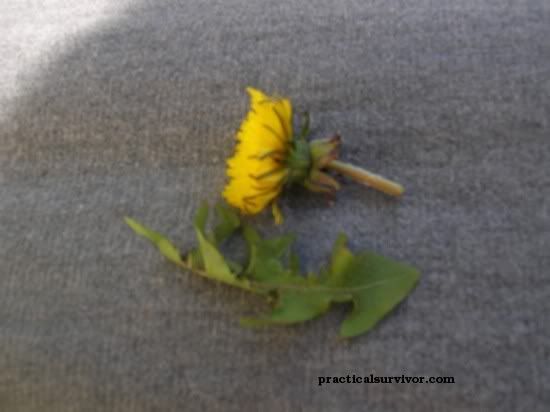

Wild Garlic (allium vineale) and Wild Onion (allium canadense)
http://plants.usda.gov/java/profile?symbol=ALVI
harvested: January 30,2008
location: North Carolina
Group: Monocot
Family: Liliaceae
Poisonous lookalikes: Death Camas (Zigadenus Michx) , Daffodil (Narcissus pseudonarcissus), Star of Bethlehem (Ornithogalum umbellatum, O. thrysoides)
Often called Wild Onions, and sometimes ramp. From what I read the leaf of wild garlic is supposed to be round and hollow while wild onion is flat. Wild garlic grows in most of the United States and parts of Canada.
I have found mixed information on the wild garlic and wild onion. What I can tell you is when you pull it up, the smell is what separates it from poisonous plants such as daffodil. Cut the plant and the bulb. Every plant we have harvested so far, looks like a wild onion to me. When I slice the bulb, the rings look like an onion. See image below:

We added the wild onions to salad with vinegar and they tasted great.
Wild garlic is edible and it has also been known to work as a bug repellent. If you read around, you will find that some companies sell garlic products by the gallon to spray on gardens to repel insects that attack plants and trees.


Nutritional value: Vitamin C, A, potassium
Poisonous lookalikes: Daffodil
Comparison pictures can be found in our: Poisonous Plants Article
Cattail (Typha)
http://plants.usda.gov/java/profile?symbol=TYPHA
harvested: February 21,2008
location: North Carolina
Group: Monocot
Family: Typhaceae
Poisonous lookalikes: Wild Iris - Yellow Flag, Blue Flag only cattail has the brown seed spike
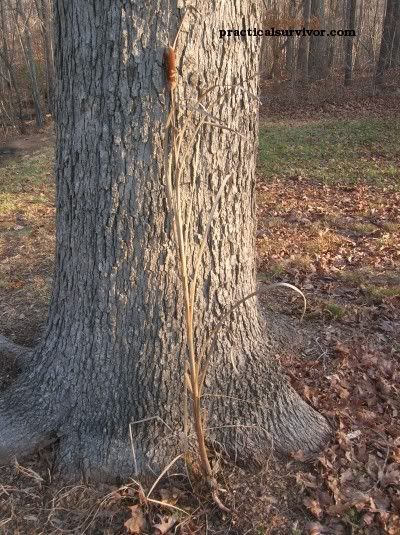
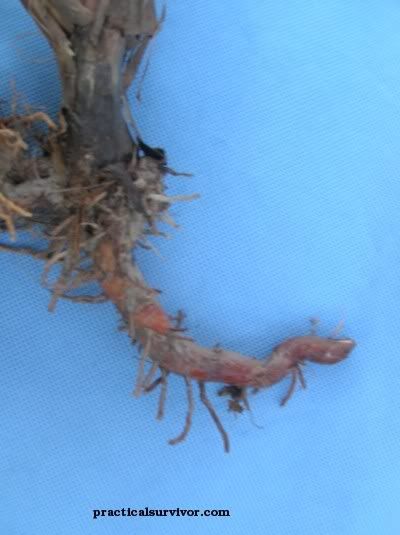
Cattail 'root' rhizome are very starchy. My personal experience is they are nothing like a potato. Different parts of the plant are edible at different times of the year. In winter we seem to be stuck with just the rhizome. In spring, summer and fall we will cover other parts of the plant such as the pollen, spikes, and shoots.
Nutritional value: Vitamin B, starch
Acorns (Oak)
harvested: February 15,2008
location: North Carolina
Group: Dicot
Family: Fagaceae
Note: There are different types of red and white oak.
White Oak (Quercus alba L.)
http://plants.usda.gov/java/profile?symbol=QUAL
Red Oak (Quercus falcata Michx)
http://plants.usda.gov/java/profile?symbol=QUFA
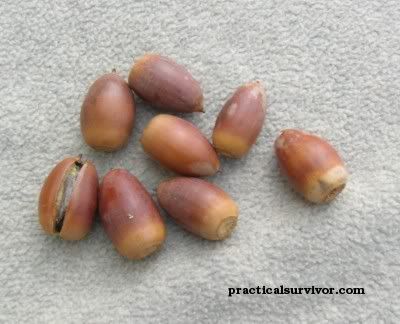
Acorns contain carbohydrates, protein, amino acids, vitamins, minerals and even fat. Although they must be prepared to eat, they are an indispensable part of a wilderness diet. The native Americans would harvest the acorns to help them pass the winters.
Acorns have the advantage of being a food source that can be stored. Acorn fat can cause the acorns to get moldy or rotten.
Preparation: Tannin should be removed from the acorns. Reducing the tannic acid from the acorns by soaking them will make them more palatable and less toxic. Some people soak the acorns a process called leaching. Others grind the acorns into flour and then treating it with hot water. Finally boiling the acorns is suggested for rapid removal of the tannins. We soaked the acorns for three days after peeling the outer shell.
dictionary.com
tannin -Any of various compounds, including tannic acid, that occur naturally in
the bark and fruit of various plants, especially the nutgalls, certain oaks, and sumac.
Tannic acid can be harmful to the human body. ** It seems tannic acid is known to reduce protein digestibilities.
http://www.ncbi.nlm.nih.gov/pubmed/9231400
"Apparent protein digestibilities were reduced by tannic acid and quebracho diets. Only the 8% tannic acid diet tended to increase glucuronidation"
The human body uses glucuronidation to make a large variety of substances more water-soluble, and, in this way, allow for their subsequent elimination from the body upon urination.
We peeled the shell of acorns to find that at this time of the year the acrons can be covered in mold. After peeling the skin and scraping the mold from the top, we put the acorn in water to leach the tanic acid out of them. After a few hours the water looked like this:
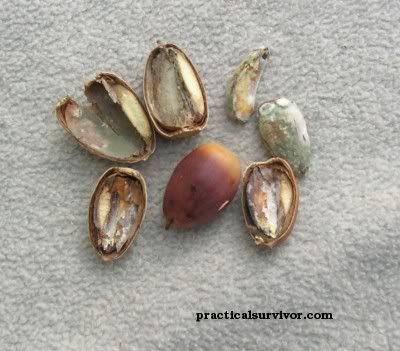
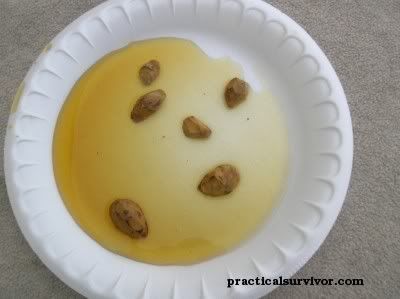
We want to avoid eating the tannin because it could cause digestive problems. When the Native Americans would prepare the acorns, they would put them in running water for days. Some people use the boiling method. We will be doing more testing. We ate an acorn before leaching the tannin out of it. Since they are moldy, they were chewy and the tannic acid caused a bitter taste. Overall the taste was that of a nut.
Most sources say that white oak acorns have the least amount tannic acid in them. This set of acorns was not very bitter but we still allowed the acorns to sit in water for three days. Changing the water periodically.
Some people say to use a boiling to speed up the process. We will research different ways of removing the tannin from the acorns and include them on the article.
We soaked the acorns for three days and dried them. Eating them and then crushing them into meal.
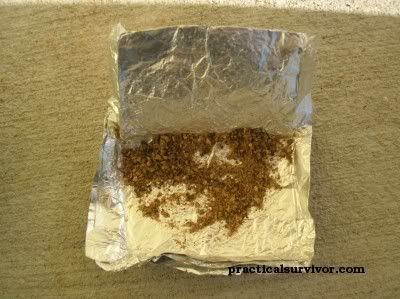
Here we use the acorn meal to make pancake mix.
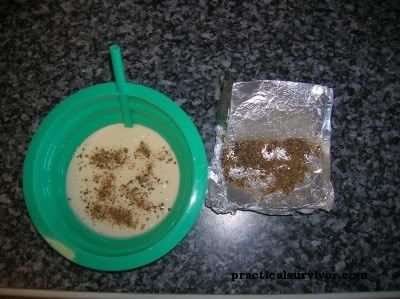

Nutritional value: protein, carbohydrates, vitamin A, C and amino acids.
Poisonous lookalikes: none
Pine (Pinus)
harvested: March 11, 2008
location: North Carolina

There are over a hundred different species of pine. Not only can the food be used as a supply of nourishment but, also can be used for medicinal purposes.
Edible parts of the pine include:
* Pine needles
* Inner bark
* Seeds
Pine needles
Pine Needle Tea


We cut the needles and add them to the bowl. There are two methods people normally use. One is to add the needles and simmer for fifteen to twenty minutes. The other is to boil the water first, and soak the needles for ten minutes.
Surprisingly the Pine needle tea does not taste as strong as most people would think. Add a little sugar if available.
Pine Needle Tea : possible health benefits
Main Entry: pine-needle oil
Function: noun
: a colorless or yellowish bitter essential oil obtained from the needles of various pines (especially Pinus mugo) and used in medicine chiefly as an inhalant in treating bronchitis
http://medical.merriam-webster.com/medical/pine-needle%20oil
My wishful thinking is that the tea will act as a treatment for sinus symptoms.
Possibly looked at as a form of homeopathic treatment, yet I am of the belief that the Native Americans found treatments for many ailments through indigenous knowledge of medicinal plants. The Native Americans believed in the benefits of pine needle tea. They frequently used it to treat:
phlegm reduction
sinus symptoms
sore throats (high vitamin C content)
ulcers
headaches
scurvy
High in vitamin C content pine needle oil is used by some in aroma therapy for sinus and infections of the respiratory system.
http://www.fiu.edu/~health/assets/pdf/AromaTherapy%20booklet.pdf
“Sinus & Cold Blend: A combination of Eucalyptus, Pine Needle, Cypress, &
Lavender. It is known for its ability to fight infections. Great to use during the
cold and flu season.”
It is also believed that eating honey from your local area may help with seasonal allergies. Honey is known for having many medicinal properties. The expectation being that the pollen gets mixed with the nectar during the gathering process. The claims are that eating the local honey will help lessen allergy symptoms.
Now I like to keep an open mind so this is all speculation on my part. The way I see it is, some of the beneficial effects of pine needle tea have been confirmed. Vitamins and minerals found are beneficial to humans. So I drink it, and nothing negative can come from it. However, it never ceases to amaze me how quickly people are willing to put a pill in their mouth because their doctor says it is going to help. This is done without any research, after being told of horrible symptoms, and the daily media posting about horrific side effects of miracle drugs. Yet when offered a possible solution from nature, they become very skeptical and misanthropic.
Some argue that the pine needle oil has antimicrobial, antibacterial and antiseptic properties. On the other side some companies have been penalized for making false representations about the overall benefits of bee pollen. So do your research and make an educated decision.
This is some of the information I found:
Recent study to examine anti-obesity effects of pine needle extract show positive results:
http://www.jstage.jst.go.jp/article/bpb/29/10/29_2111/_article
http://www.ncbi.nlm.nih.gov/pubmed/17474862
“These results demonstrate that pine needles exhibit strong antioxidant, antimutagenic, and antiproliferative effects on cancer cells and also antitumor effects in vivo and point to their potential usefulness in cancer prevention.”
Note:
Thank you to Jan Wilson from bringing this to our attention. It seems that pine needle can cause abortions
This seems to only affect cattle. We do not know if it affects humans, but perhaps a caution to pregnant women should be mentioned.
The ranchers in our area of central BC know well the effects of having their cattle drink from puddles in which pine needles have been soaking. The cows will abort their calves.
scroll down to page 15/16 for the information.
http://74.125.155.132/search?q=cache:TsGqvjgq_LwJ:www1.foragebeef.ca/%24...
More info here
http://www.vetmed.ucdavis.edu/vetext/INF-BE_cca/INF-BE_cca96/INF-BE_cca9...
and here
http://cekern.ucdavis.edu/Custom_Program813/Pine_Needle_Abortion.htm
researching:
Zizania aquatica
American Ginseng
Western NC Blue Cohosh
Pink and yellow lady slippers
UNDER HEALTH WE WILL HAVE A MEDICINAL PLANT SECTION
The USDA government web site includes a map of Canada and the United States with each plant. The map covers areas where the plant is available. The site includes a name search engine.
Recommended Reading:

practicalsurvivor.com is licensed under a Creative Commons Attribution-Noncommercial-No Derivative Works 3.0 Unported License.



